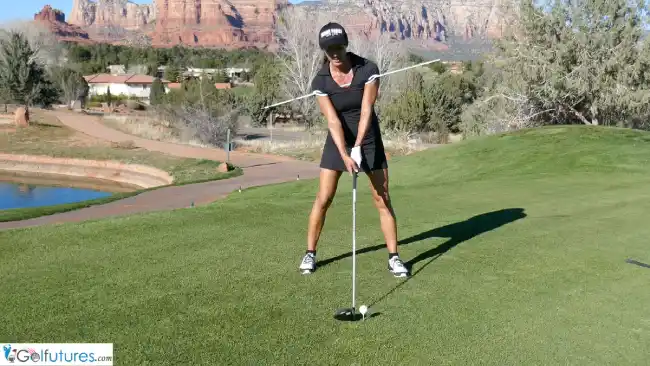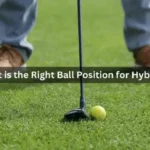When it comes to hitting a driver effectively, understanding the correct ball position for is crucial. The way you position the ball in relation to your stance can significantly impact your swing, ball flight, and overall performance on the golf course.
In this article, we’ll break down the essentials of ball placement and the impact it can have on your game, ensuring you’re set up for success on your next swing.
Correct Ball Position for Driver
The general opinion among golf professionals is that for the driver, the ball should be positioned more towards your front foot. This positioning is essential for achieving both an optimal launch angle and maximizing distance


Here are the steps to ensure optimized ball position when using your driver:
- Align your feet: Stand straight and place your feet shoulder-width apart. This provides a solid foundation for your swing.
- Set your ball position: Align the ball slightly forward with your left heel (for right-handed golfers) or right heel (for left-handed golfers). This allows you to strike the ball on the upward part of your swing.
- Check your grip: Ensure your grip is secure and relaxed. A firm grip helps maintain control over your swing.
- Focus on your stance: Keep your knees slightly bent and your weight distributed evenly. This balance aids in maintaining a steady swing.
- PRACTICE: don’t forget the importance of practice. Spend time on the driving range experimenting with your ball position to see how it affects your swing and distance.
Why is Ball Position Important?
A consistent ball position helps you establish a reliable and repeatable swing path, which can lead to greater accuracy and distance.
Here are some key reasons why it’s important to position the ball correctly:
- Launch Angle: A correct forward ball position encourages an upward strike at impact, resulting in a higher launch. This is ideal for maximizing distance since the ball can carry further when launched at the optimal angle.
- Spin Rate: Ball positioning affects spin. If the ball is too far back in your stance, it might produce excessive spin, causing the ball to lose distance. Conversely, with proper forward placement, the spin can be more manageable, enhancing distance.
- Consistency: A consistent ball position in your stance leads to a more predictable swing path. It allows you to replicate your swing more easily, leading to better performance over time.
- Impact Spot: When the ball is placed forward, you increase the likelihood of striking it with the sweet spot of your driver, leading to better energy transfer and greater distance.
How to Adjust Your Ball Position for Different Course Conditions

In golf, adjusting your ball position based on the course conditions can significantly improve your performance. Different terrains, weather, and types of grass can impact the way you hit the ball.
Here’s a closer look at how you can modify your ball position effectively.
Firm Fairways
On firm fairways, the ball tends to sit up nicely, allowing for a clean hit. When facing this condition, position the ball slightly forward in your stance. Try placing it just inside your left heel (for right-handed golfers).
This position encourages a sweeping motion, letting the club glide through the ball without digging into the ground.
Key Tips for Firm Fairways
- Place the ball inside your left heel if you’re right-handed.
- Use a sweeping motion to maintain balance.
- Aim for a higher follow-through for maximum distance.
Soft or Wet Fairways
Soft fairways can present challenges due to potential mud and uneven surfaces. In this situation, consider moving the ball slightly back in your stance. Position it around the center or just behind the middle of your stance to prevent the club from getting caught in the ground on impact.
This method promotes solid contact and helps avoid unnecessary loss of control.
Key Tips for Soft or Wet Fairways
- Shift the ball back to the center of your stance.
- Focus on a downward strike to penetrate through the soft turf.
- Keep your swing smooth and controlled to maintain accuracy.
Uphill Lies
When dealing with an uphill lie, the angle of the slope influences your swing mechanics. To adjust your ball position here, raise the ball slightly in your stance by placing it closer to your left heel.
This adaptation allows for a more upward strike, helping you to achieve loft and distance while minimizing the risk of hitting the ground first.

Key Tips for Uphill Lies
- Position the ball near your left heel to promote an upward strike.
- Adjust your stance to maintain balance on the slope.
- Keep your follow-through high to ensure loft on the shot.
Downhill Lies
Conversely, when you’re on a downhill lie, your approach must change as well. Position the ball a bit back in your stance, closer to your right foot.
This not only helps you make solid contact but also prevents the club from hitting too far behind the ball, which can happen on a downward slope.

Key Tips for Uphill Lies
- Position the ball towards your right foot.
- Focus on maintaining balance throughout your swing.
- Keep your head steady to avoid pulling the shot.
Adjusting for Wind Conditions
Wind can also affect your ball position. When playing into the wind, move the ball slightly back in your stance. This positioning can help keep the ball low and make sure it doesn’t balloon up, which is critical for controlling distance.
Conversely, if you are hitting with the wind, position the ball slightly forward to allow for a higher launch, maximizing distance.
Key Tips for Wind Conditions
- Against the wind: Move the ball back in your stance to keep the ball flight low.
- With the wind: Position the ball slightly forward to take advantage of a higher launch.
- Stay aware of wind direction and adjust accordingly.
By understanding how to adjust your ball position based on different course conditions, you give yourself a better chance to play effectively.
Practice these techniques regularly to better your game and enjoy the benefits of a well-measured shot, no matter where you find yourself on the course.
Common Mistakes in Ball Positioning When Hitting the Driver
When it comes to golf, even small mistakes can impact your performance significantly. Here are some common errors golfers make regarding ball placement and how to fix them to improve your game.
Ball Position Too Far Back
One of the most frequent mistakes golfers make is placing the ball too far back in their stance. This often leads to hitting the ball with a descending blow, causing topspin.
Instead, you want to achieve a level or slightly upward angle at impact for maximum distance. Position the ball just inside your left heel if you are a right-handed golfer.
This helps you strike the ball correctly and optimize launch angle.
Ball Position Too Far Forward
Conversely, positioning the ball too far forward can also create problems. When the ball is too close to your front foot, it can result in a slice, as the clubface may open at impact.
To ensure the clubface meets the ball squarely, keep the ball positioned towards the inside of your left heel. This way, you allow the club to pass through the ball with greater control.
Not Considering the Driver’s Loft
Different drivers have varying lofts, and this affects the optimal ball position as well. If you use a driver with a lower loft, such as 8 or 9 degrees, you might benefit from placing the ball more forward.
Higher-lofted drivers (10.5 degrees and above) work better with a more central ball position. Understanding how your driver reacts to different positions can significantly enhance your overall swing.
Ignoring Your Stance Width
Your stance width also plays a crucial role in ball positioning. If your feet are too close together, the ball may not fly straight. A wider stance stabilizes your swing and allows for better rotation.
Ensure your shoulders and feet align with your target while keeping your stance firm. As a guideline, your feet should be about shoulder-width apart to maintain balance and control during the swing.
Failing to Adjust for Playing Conditions
Sometimes, weather conditions might affect how you position the ball. On windy days, you might want to play the ball slightly back in your stance to ensure better control and minimize the impact of the wind.
In contrast, on calm days, position the ball forward to take advantage of the increased distance.
Remember to stay flexible and make adjustments based on your surroundings.
Neglecting Body Alignment
Your body alignment is just as vital as your ball position. Many golfers focus solely on where the ball is set without considering their shoulders and hips. Misaligned body parts can lead to inconsistent shots.
Ensure your body aligns parallel to your target line. Take a moment to check your alignment before settling into your stance. Correcting any misalignments at this stage can improve your overall swing.
Not Practicing Enough
One of the biggest pitfalls is simply not practicing regularly. Finding the right ball position takes time and practice. Set aside time to work on your driver swing, paying special attention to ball positioning.
Repetitive practice can help cement the correct habits in your muscle memory, leading to more consistent performance on the course.
By being mindful of these common errors and making a conscious effort to correct them, you can elevate your game and enjoy more successful drives on the golf course. Remember, focusing on the right ball position is essential for achieving the best results with your driver!
FAQS
Q: How does ball position affect my driver distance?
A: Yes. Faster swing speeds can benefit from positioning the ball slightly forward for optimal compression, while slower swing speeds may find more control with the ball slightly further back
Q: Does tee height impact ball position for drivers?
A: Yes, tee height can influence how you position the ball in your stance. Higher teeing is recommended when the ball is positioned forward to allow for upward strikes, maximizing both carry and roll
Q: Should I adjust ball position based on my swing speed?
A: Yes. Faster swing speeds can benefit from positioning the ball slightly forward for optimal compression, while slower swing speeds may find more control with the ball slightly further back
Q: Does ball position change in windy conditions?
A: Yes, in windy conditions, moving the ball slightly forward in your stance can help you keep the trajectory lower, especially when hitting into a headwind.
Q: Does ball position affect slice or hook shots?
A: Yes, incorrect ball position can influence shot direction. Too far forward often results in a slice, while too far back may cause a hook.







